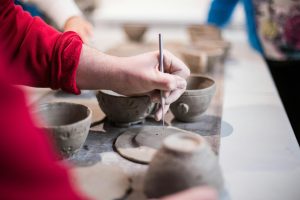High school is an important period for students to prepare for further education and future career. For many students, high school is particularly academically demanding as most students desire to get accepted by their dream colleges, and academic achievements are a significant part of what colleges look at. During high school, it is common for students to dedicate more effort to studying and less to extracurricular activities. However, extracurricular activities, especially music and art education, are equally significant in high school.
While students get overwhelmed and exhausted from their school work, a break and meditation to relieve their stress is necessary. Art and music activities are always popular with students. According to a study by Arts ED NJ, “49.9%

of high school students in New Jersey participated in one or more arts disciplines during the 2014/2015 school year. Among the arts disciplines, visual art has the greatest percentage of enrollment at 31.1%, followed by music at 17.9%” (Arts ED NJ). The findings indicate high school students’ significant involvement and interest in music and art education. In these arts electives, students can enjoy their interests and forget their stress. For instance, during choir classes, students can vent their emotions through singing and learning about music.
The process of learning music and art enhances students’ general learning skills. It develops imagination, logical
thinking, and concentration. Music and art education encourage students to apply their creativity and imagination in work. In art classes, students use their creativity and imagination to create unique artworks. In music lessons, students use their imagination to express their feelings and convey messages through music.
Meanwhile, it develops thinking skills as creating artwork and learning music require students to think and interpret different elements. For example, to create a painting about happiness, students need to consider the central theme and then utilize different art elements, such as colors and values, to emphasize the theme. They may use warm-tone colors like yellow and orange to express happiness. Their general learning skills, such as muscle coordination and concentration, are strengthened throughout the procedures. A study from the University of British Columbia collected over 100,000 students at public high schools in British Columbia and found that students who took music lessons got higher grades in many school subjects (Amsen). A researcher from the study, Martin Guhn, explained that in learning music, students need to read music notation, develop eye-hand-mind coordination, listening skills, and discipline to practice (Amsen). The research shows that music education significantly improves students’ learning skills and academic performance.
As Win Butler, a famous American-Canadian musician, says, “Everyone has their talents. It’s up to the individual to

see what you can do.” Many students have incredible talents in performing arts, and it is essential to provide a chance for them to explore their interests and showcase their talents. For some students, schoolwork is not always where they excel. However, they could be gifted in the fields of music and art. Through music  and art education, students can earn their confidence and motivation. They may even discover what they want their future jobs to be. Being proficient in music or arts amplifies college applications. Colleges also look at extracurricular activities, aside from academic performance, because they show that the students are well-rounded in areas besides academics.
and art education, students can earn their confidence and motivation. They may even discover what they want their future jobs to be. Being proficient in music or arts amplifies college applications. Colleges also look at extracurricular activities, aside from academic performance, because they show that the students are well-rounded in areas besides academics.
Although it is an undisputed fact that high school is a crucial time for students to prepare for their future, it does not mean students should spend all their time studying. Students deserve to learn and explore different interests, such as music and art. High schools should not constrain students by limiting them. Instead, high schools are responsible for providing a place where students can explore and realize their full potential in all areas.
Sources:

